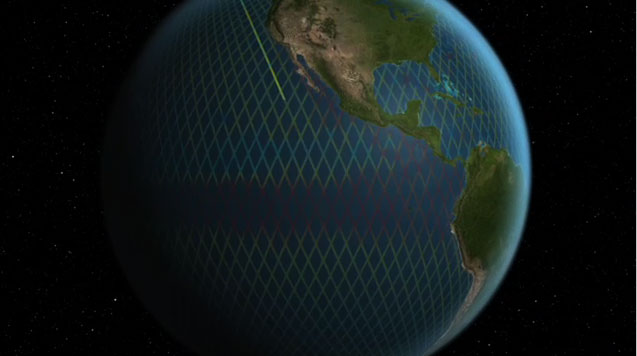Scientist suggests grass up the beach

Close Scrutiny: Artist’s impression of the grid traced by the satellite Jason-1, continuously measuring sea level height. image NASA JPL-Caltech
It is synonymous with summer at the beach.
Swimming, interspersed with luxuriating in the warm, soft, dry sand of the beach.
Increasingly though, the reality is hard-packed sand all the way to the seawall. The practice of building near the shoreline was always going to be at the sacrifice beaches when shorelines recede—invariably periodically shorelines advance and recede. Sometimes this is due to storms, other times it is to do with a pulse of sand moving inexorably along a coast, as it does classically on the region’s west coast beaches.
Satellite altimeter measurements since 1992 show an increase of about 3.2 millimetres per year sea level rise—58 millimetres in 18 years. This is almost double the 1.8-millimetre average rise for the 20th century recorded by tide gauges. The rate of future level rise is fiendishly difficult to forecast, but most unlikely to be linear. The newest satellite, Jason-2, has been operating since 2002. Technologies and data methodologies continue to be fine-tuned, and providing an ever-clearer picture.
New Zealanders’ perception of a natural beach tends to be skewed. Many beaches used for recreation lack a natural ingredient—grass. Indigenous sand-binding grasses were made short work of by sheep and cattle, leaving lovely soft sand that is the perfect way to warm a body after swimming in Aotearoa’s often altogether too temperate waters. In beaches naturally well supplied by fresh sand, this was satisfactory short term, but ultimately unsustainable. The lack of sand-binding plants means that precious sand is lost from the beach, typically by being blown inland.
In many situations, the addition of a seawall simply ensures that the much-loved soft sand is a thing of the past—Ōrewa is a classic example. The principal problem there, or course is the residential development—the vision of Captain F W O Jones ignored.
Ōrewa was long a staging post for Dr David Bergin in his many trips from Rotorua to Northland, for his work with sustainably-grown tōtara, and with pōhutukawa. More recently though, Dr Bergin, with his assistance and son Michael Bergin, have forsaken Ōrewa in favour of Ōpahi—Dr Bergin being the scientist behind the Mahurangi open-ground indigenous plants project. During their stays at Ōpahi, as John Timmins’ guests, the Bergins have educated locals as to what to look for in a beach that could benefit from being planted in sand-binding plants. One of the signs is where sand is being lost from the beach by being blow inland, which is exactly what is happening at Ōpahi.
This weekend pīngao and spinifex will be planted at Ōpahi, in a number of small trial plots. If the plants successfully establish, it is likely that they will help build a small dune. Such vegetation does not armour the beach during a storm. It can, however, absorb some of a storm’s force, as waves bite into the dune. Sand-binding plants will be lost, but probably not all and will readily grow back. The aim is to increase the natural resilience of the beach.
Dr David Bergin is one of Aotearoa’s leading foreshore vegetation scientists. Wherever he works, folk invariably take the opportunity to pick his brains about their favourite project. It had been hoped that the Bergins—David’s wife Sue is making her second trip to the Mahurangi—could stay to attend Monday evening’s Mahurangi Club, so that more folk could learn about this important work.
This has not proved possible, but with the first-Monday-in-the-month gatherings gaining momentum, it is probable that Dr Bergin will be the speaker at a subsequent gathering.
